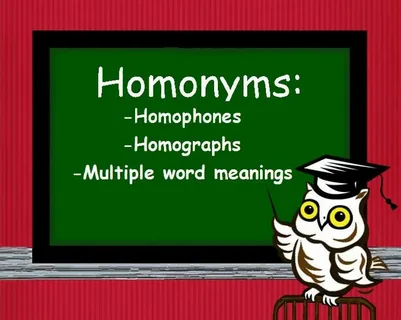Introduction
The English language is a tapestry woven with fascinating patterns and occasional inconsistencies that reflect its rich historical development. Among its most intriguing features are What are homographs and What are homonyms, two types of word relationships that exemplify the complexity and versatility of English vocabulary. These linguistic phenomena not only present challenges for language learners but also provide opportunities for creative expression and wordplay that enhance the richness of communication.
Homographs: Same Spelling, Different Stories
Homographs are words that share identical spelling but differ in meaning, origin, or pronunciation. The term comes from Greek roots: “homos” meaning “same” and “grapho” meaning “write”—literally “written the same.”
These words fall into two main categories:
- Homographs with different pronunciations (also called heteronyms):
- Bow (/baʊ/ as in taking a bow) vs. bow (/boʊ/ as in bow and arrow)
- Lead (/lɛd/ as in the metal) vs. lead (/liːd/ as in to guide)
- Wind (/wɪnd/ as in moving air) vs. wind (/waɪnd/ as in to turn)
- Homographs with the same pronunciation:
- Bank (financial institution) vs. bank (side of a river)
- Bark (tree covering) vs. bark (dog sound)
- Ring (circular object) vs. ring (sound of a bell)
This second category overlaps with homonyms, creating some of the terminology confusion we’ll address later.
Homonyms: The Broader Category
The term “homonym” has varying definitions depending on the linguistic source. In its broadest sense, homonyms are words that share the same form (written or spoken) but have different meanings. The word derives from Greek “homos” meaning “same” and “onyma” meaning “name.”
According to , homonyms can refer to:
- Words that sound alike (homophones)
- Words that are spelled alike (homographs)
- Or both
Some language specialists prefer a narrower definition, arguing that true homonyms should be both spelled and pronounced identically while having different meanings—essentially making them the intersection of homographs and homophones.
Examples of strict homonyms (same spelling, same pronunciation, different meanings):
- Fair (just) vs. fair (carnival)
- Spring (season) vs. spring (water source) vs. spring (to jump)
- Bear (animal) vs. bear (to carry)
Clarifying the Terminology: A Visual Framework
To understand the relationship between these terms, consider this framework:
- Homophones: Words that sound the same regardless of spelling
- Example: meet/meat, there/their/they’re, see/sea
- Homographs: Words that are spelled the same regardless of pronunciation
- Example: lead/lead, bow/bow, wind/wind
- Strict Homonyms: Words that are both spelled and pronounced the same but have different meanings
- Example: bark/bark, bat/bat, fair/fair
Under the broader definition, homonyms encompass both homophones and homographs, making it a superordinate category. This explains much of the confusion surrounding these terms, as different sources may use different definitions.
The Historical Development of Homographs and Homonyms
The abundance of homographs and homonyms in English is not accidental but the result of several historical processes:
Multiple Language Sources
English vocabulary draws from Germanic roots, Latin, French, Greek, and many other languages. This diverse etymology occasionally results in words from different language families coincidentally developing similar forms in modern English.
Phonological Changes
Over centuries, English pronunciation has evolved dramatically while spelling has remained relatively static. The Great Vowel Shift (14th-18th centuries) changed how many words were pronounced without corresponding spelling changes, creating many homographs with different pronunciations.
Semantic Evolution
Words that once had a single meaning have evolved to encompass multiple, sometimes unrelated concepts. For example, “fair” originally referred to beauty but expanded to include concepts of justice and festival events through different etymological pathways.
Spelling Standardization
When English spelling became standardized in the 18th century, words with different historical pronunciations sometimes ended up with identical spellings, creating more homographs.
The Cognitive Challenge of Processing Ambiguity
From a psycholinguistic perspective, homographs and homonyms present fascinating challenges to our language processing systems:
Lexical Ambiguity Resolution
When we encounter a word with multiple potential meanings, our brains engage in a process called lexical ambiguity resolution. Research suggests that initially, all possible meanings are briefly activated before context helps select the appropriate one.
Context-Dependent Processing
Studies using techniques like eye-tracking reveal that contextual clues influence how quickly we process homographs and homonyms. When context strongly supports one meaning, we resolve ambiguity faster than when context is neutral or supportive of multiple interpretations.
Frequency Effects
The frequency with which different meanings of a homograph or homonym occur in language affects processing. More common meanings tend to be accessed more quickly, even when context suggests a less frequent interpretation.
Common Misconceptions About Homographs and Homonyms
Several persistent misconceptions surround these linguistic concepts:
Misconception 1: Homonyms and Homographs Are the Same Thing
As we’ve seen, while there is overlap, these terms have distinct definitions. Using them interchangeably oversimplifies the complex relationships between word forms and meanings in English.
Misconception 2: English Is Unique in Having These Features
While English has an abundance of homographs and homonyms due to its particular history, most languages have some form of these word relationships. The specific patterns may differ, but lexical ambiguity is a common feature across languages.
Misconception 3: These Word Types Always Create Confusion
Although homographs and homonyms have the potential to cause ambiguity, in natural language use, context usually provides sufficient clues to determine the intended meaning. Our brains are remarkably efficient at resolving these ambiguities in real-time.
Misconception 4: Children Learn These Naturally Without Instruction
While native speakers eventually master homographs and homonyms, research shows that understanding of these relationships develops gradually. Explicit instruction can help accelerate this process, particularly for challenging cases.
The Significance of Homographs and Homonyms in Language Learning
For English language learners, homographs and homonyms present unique challenges:
Vocabulary Expansion Challenges
Learning that a familiar word has multiple unrelated meanings requires creating additional mental entries for what appears to be the same word. This process is cognitively demanding and differs from simply adding new words to one’s vocabulary.
Pronunciation Hurdles
For homographs with different pronunciations, learners must master subtle distinctions that might not exist in their native language. The lack of consistent patterns makes this particularly challenging.
Contextual Dependency
Understanding which meaning is appropriate in a given context requires developing sensitivity to subtle contextual clues that native speakers process automatically.
Cultural Knowledge
Many uses of homographs and homonyms in idioms, humor, and cultural references assume familiarity with multiple meanings. Missing these connections can lead to misunderstanding cultural content.
Teaching and Learning Strategies
Educators and learners can employ several effective strategies for mastering homographs and homonyms:
Contextual Learning
Rather than memorizing lists of homographs and homonyms in isolation, studying them in varied authentic contexts helps internalize their different meanings and appropriate usage.
Visual Mapping
Creating visual representations that connect the same word form to its different meanings helps establish separate semantic networks for each sense.
Etymology Exploration
Understanding the historical origins of different meanings can provide memorable narratives that help distinguish between seemingly identical forms.
Contrastive Analysis
Explicitly comparing and contrasting different meanings of the same word form helps establish clear boundaries between concepts.
Multimedia Reinforcement
Using images, audio, and video to represent different meanings engages multiple learning modalities and strengthens mental associations.
Homographs and Homonyms in Creative Expression
Beyond their everyday uses, these word relationships offer rich creative possibilities:
Literary Devices
Writers use homographs and homonyms to create:
- Puns: Wordplay that exploits multiple meanings
- Double entendres: Phrases with two interpretations, often one innocent and one suggestive
- Ambiguity: Intentional vagueness that adds depth or multiple interpretations
Advertising and Marketing
Creative professionals leverage these linguistic features to craft memorable taglines and brand names. The effectiveness often lies in the cognitive pleasure we experience when resolving clever wordplay.
Humor and Comedy
Many jokes rely on the temporary misinterpretation of homographs or homonyms, with the punchline revealing the alternative meaning that creates a humorous reframing of the scenario.
Homographs and Homonyms in the Digital Age
Modern technology has created new challenges and opportunities related to these linguistic features:
Search Engine Optimization
Content creators must consider how search algorithms process homographs and homonyms when optimizing for relevant keywords, often using contextual phrases to clarify intended meanings.
Natural Language Processing Challenges
For AI systems and language models, resolving the ambiguity of homographs and homonyms remains a significant challenge, requiring sophisticated contextual analysis.
Autocorrect and Predictive Text
Mobile devices and word processors sometimes struggle to predict the correct form of homophones or the intended meaning of homographs, leading to amusing or frustrating autocorrect errors.
Conclusion
Homographs and homonyms embody the beautiful complexity of the English language, reflecting its rich historical development and remarkable adaptability. While they can present challenges for learners and occasionally lead to amusing misunderstandings, they also provide opportunities for creativity, wordplay, and linguistic exploration.
Understanding these word relationships enhances not just vocabulary knowledge but also deepens appreciation for the contextual nature of meaning in language. These linguistic features remind us that communication is not simply about words in isolation but about how meaning emerges from the intricate dance between form, context, and shared understanding.
Whether you’re a student, teacher, writer, or simply a language enthusiast, exploring homographs and homonyms offers valuable insights into the fascinating ways language works and the remarkable cognitive capabilities that allow us to navigate its complexities with such apparent ease.
By embracing rather than avoiding these potential sources of ambiguity, we can enhance our linguistic versatility and enjoy the rich expressive possibilities that English offers through these chameleon-like words that change their meaning while maintaining their form.


